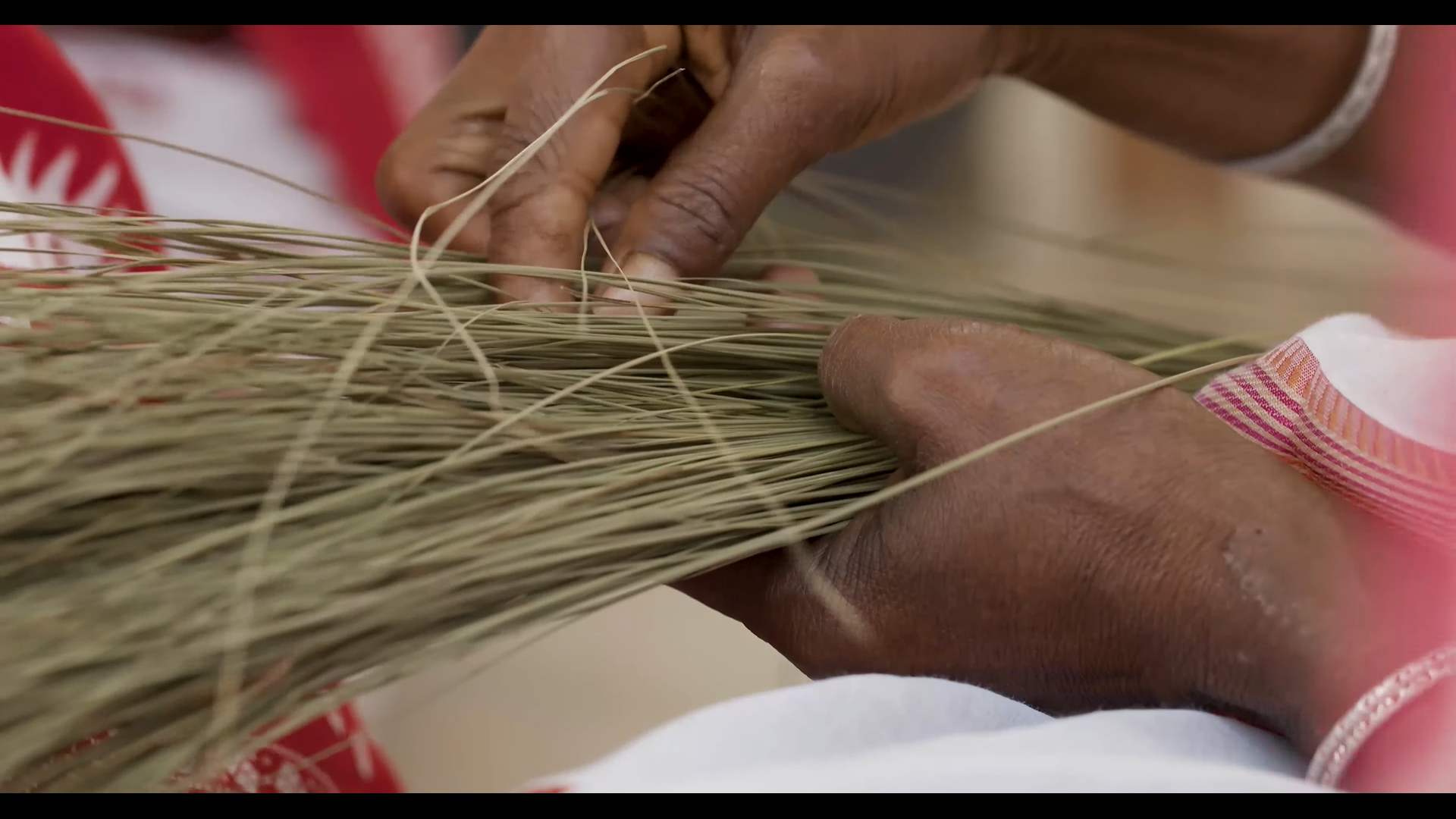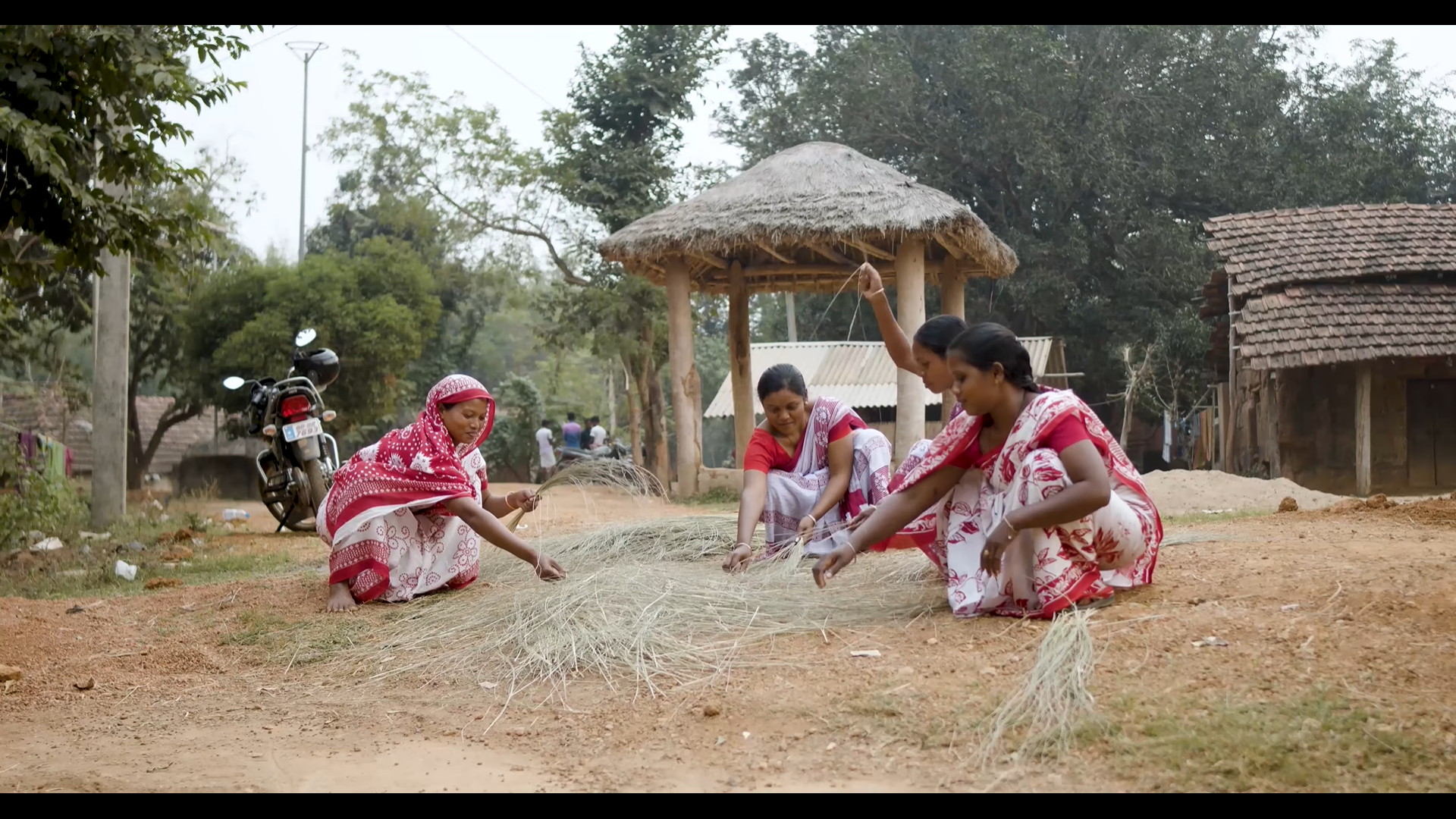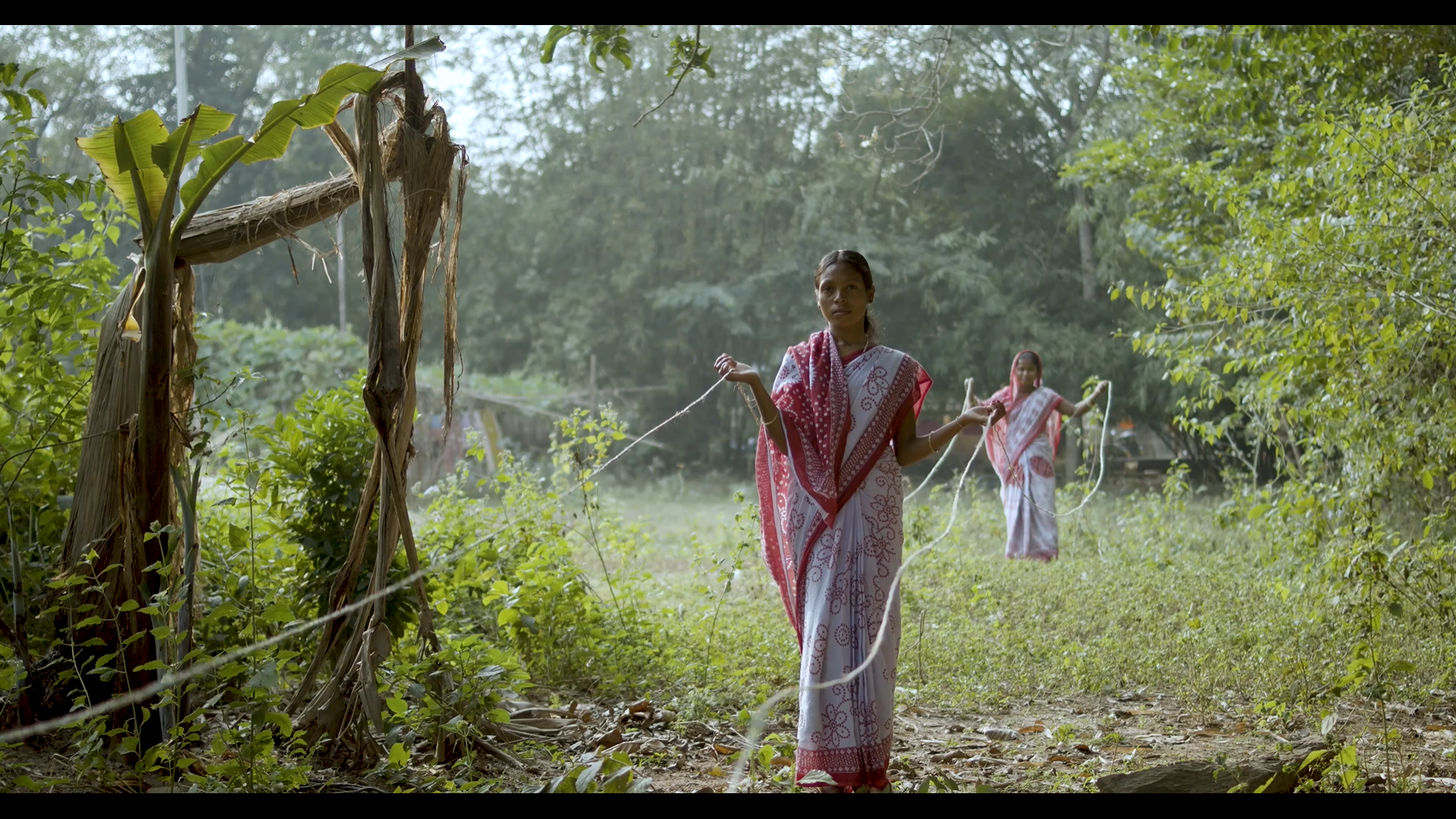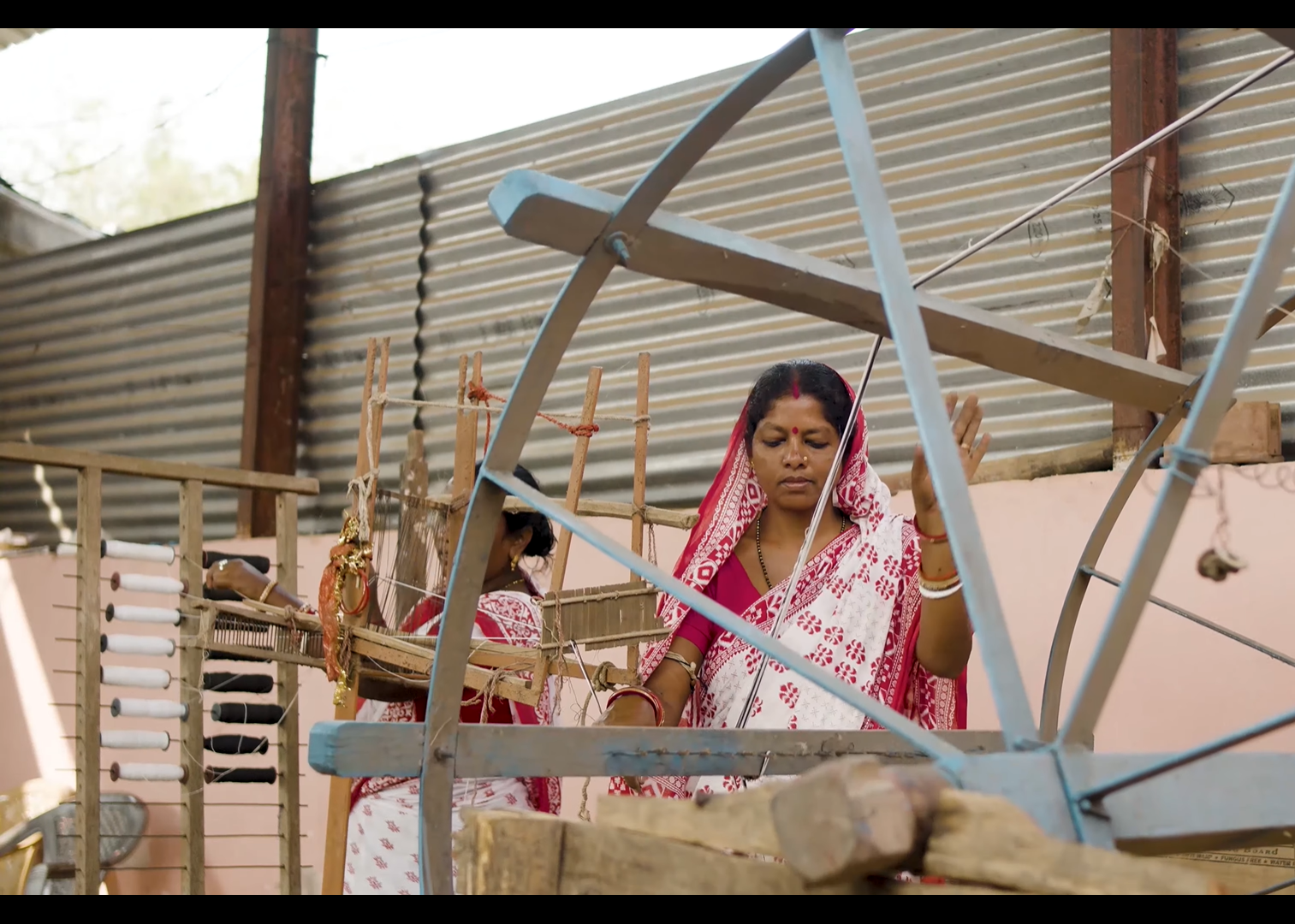Grew From Grass
A women-run self-help group in Odisha
turns profits through its eco-friendly
handicraft products

The story is in a series that feature companies putting responsible business practices to work in achieving business success. UNDP and the EU, joint partners in the Business and Human Rights in Asia project, applaud enterprises that put the UN Guiding Principles on Business and Human Rights at the centre of their business strategies and operations.
Women's labour force participation in India has been dismal. With only 27.7% women in rural areas participating in the labour market, it is in strong contrast to that of men at 57.1% (PLFS, 2020-21).
Self-help Groups or SHGsare considered essential to correct the power imbalance and provide women with a credit-linked safe workspace that has a common goal. This is the story of a SHG where women trained themselves — in both Sabai handicraft work and fighting gender-based prejudice — to build a business enterprise and gain financial independence.

Enter, USHA RANI NAIK
She was in a tearing hurry. Anger and helplessness rose within her. Bending, rising, bending she picked up twigs and sticks from the forest floor. Her eyes darted back-and-forth, searching for more, back-and-forth, to the rhythm of a clock that ticked inside her mind. There was no time. Very soon she would have to leave for the market to sell whatever she had collected, and then make the long journey back home.
She hoped she would have the money for the event that awaited. It was Usha Rani’s wedding day. She was 14. A child bride. But her parents had no money to arrange a meal for the groom's family and friends. So Usha left home early that morning to forage and gather the resources for the prelude to her new life.
Her new home was the Gujaldihi village in the Mayurbhanj district in Odisha. But marriage did not alter her financial conditions. Her new husband did not have a job. Neither were opportunities forthcoming in the village. A range of odd jobs that neither fulfilled her financially nor spiritually followed. Usha was grasping at straws. She needed a turning point, a crack in the bolted door.
But the wait seemed endless.

Women in Rural India

In many parts of the world like Mayurbhanj in Odisha, economic opportunities are sparse, agriculture seasonal and unreliable, and migration to larger cities the only alternative.
Communities in the Mayurbhanj district continue to be amongst the poorest in the country. Paddy and wheat cultivation offers them some income, but it’s seasonal work. The State must then shoulder the responsibility of helping citizens upskill and enter a trade that can assure them a dignified and decent livelihood.
While poverty is rife, it’s women like Usha who live especially perilous lives. Many women — across classes in India — are pigeonholed as ‘housewives’ and prevented from holding outside jobs. The few who do -grapple with an informal nature of work marked by exploitative conditions, poor wages, and low social security benefits.
Disclaimer

A UNDP B+HR study on women garment workers in India shows that many women work overtime in deplorable conditions without a break, do not receive social security, pension or health benefits, and have no provisions for grievance redressal.
This is exacerbated due to concerns of caste and ethnicity, especially in a district like Mayurbhanj where about half the population belongs to Scheduled Tribes (communities among the most socio-economically disadvantaged in India), according to the 2011 census.
In 2011, the United Nations Human Rights Council unanimously adopted United Nations Guiding Principles (UNGPs) on business and human rights as a set of guidelines for states and businesses to prevent and address human rights abuses committed in business operations. Guiding Principle 2 demonstrates that States should set out clearly the expectation that all business enterprises domiciled in their jurisdiction respect human rights throughout their operations. When read through a gender lens, it becomes important for States to not only provide guidance, but also create incentives to encourage businesses to respect women's rights.


It was through a State-provided incentive that Usha and other women of Gujaldihi village attempted to propel their life forward. One day in the early 2000s, Usha met a district official and learnt how Sabai, a type of grass swaying in her backyard, had reached the hands of artisans.

Usha believed that she had the right to a livelihood, to earn to support her family, but village social norms and prejudice against women meant that few women had received formal education or were allowed to step out of their homes to make a living. A new dimension opened when the district official informed her that if she formed and registered a Self-help Group (SHG) of about a hundred women in her village, she could benefit from state subsidies.
In addition to the brewing national movement on SHGs, the Odisha government set up the Odisha Rural Development and Marketing Society (ORMAS) in 1991, an autonomous body to facilitate rural development, women empowerment, livelihood activities, and marketing of rural products. It also offered loans to rural artisans to improve their economic condition. ORMAS’s incentives like institutional support, loans and grants directed specifically at women-run SHGs aimed at incentivising women workers to join the workforce.
But a hundred women? It was a formidable task but Usha rose to the occasion. For a good part of 2001, she went from door-to-door convincing women of Gujaldihi to become part of the SHG. Not just the families, the women themselves were opposed to the idea of working with Sabai Grass.

Usha tried to persuade the women by focusing on the benefits:
1It was safe because it was a women-only group.
2There would be no commute because they could work from their homes or a common village centre.
3And more importantly, the money they earned would supplement their family income.
But the women dithered. Elders in the family frowned at the idea of a woman taking up outside work. Usha persisted and what eventually won the women over was the promise of an additional income that could enable a better quality of life. At first, Usha managed to bring fifty women together but she didn't stop till a hundred women pledged to join her. Thus, the Gujaldihi SHG was formed. Now they were eligible for support from the government.
But before she and the other women of the SHG could benefit from loans, they needed training. Sabai grass may not have been unfamiliar to them, but the craft of twisting it, braiding it, dying it, to produce decorative items was uncharted territory. After a six-month training from the District Industrial Centre (DIC), they were open for business.

SABAI GRASS
A particular type of grass — long, thin, with a sharp texture is grown in the forest fringes of Odisha, West Bengal and some other parts of India. The land is often barren and once sowed, the grass grows without the need for water or fertilisers for the next four or five years. It is called sabai or Eulaliopsis binata.
Light and durable, this grass has been traditionally used to make ropes. It's not uncommon to see bundles of dried grass being exported out of Odisha or cots being stitched through its ropes. But there's one more quality of the grass that has remained relatively unexplored: it can be easily dyed. And it's perhaps how the grass, usually twisted to make ropes, began to be braided and dyed to create beautiful handicraft products like mats, bins, wall hangings, jewellery and a lot more, that offer supplementary income to women in Odisha’s villages.
In 2001, Usha and other members of her SHG received Rs 50,000 (around 638 USD) from ORMAS. They used that money to buy Sabai grass from a dealer. Raw material secured, the women sat under the shade of a tree and put their recently-learnt skills to test. A month later, 50-60 handicraft products were ready and they now had to find an avenue to sell them. Usha thought of Puri, Odisha’s holy city and old handicraft centre, and left with a few other members to sell the handicrafts.
But they returned disappointed.
Beginner’s luck had eluded the Gujaldihi SHG but Usha tried again by taking the handicrafts to an exhibition in Delhi. This time, they succeeded in selling products worth Rs 30,000 (around 383 USD). But they didn’t return home to a hero’s welcome. After the exhibition, the women’s families, suspicious of their whereabouts, refused to let them in. Usha and the other women spent the night outside. The battle at home was proving impossible to resolve but as they continued to sell their products and earn money, the anger at home dissipated and acceptance emerged.
From then, until the next decade, exhibitions became a major part of the SHG’s sales strategy. Bhubaneswar, Puri, Delhi, Mumbai— Usha and her group travelled far and wide with their products. ORMAS reimbursed their travel while the women did the hard, tireless work of showcasing the beauty and durability of the Sabai grass.
It’s not bamboo, no, they cleared customers' common misconception, while showing off the grass’s sturdiness, gaining recognition, and driving additional income back to their villages. Ten years later, in 2014, the SHG made Rs 1,95,000 (around 2400 USD) in profits. “It was then that I thought of us as financially successful,” Usha said. In 2016, as per instructions by ORMAS, the Gujaldihi SHG and other SHGs were merged to form a producer group. The secretary of each SHG was appointed as director of what was called the Mayurbhanj Sabai Farmers Producer Company.

1Flexible nature of work has long been touted as an incentive to persuade women to join the workforce — and Sabai craft fulfills this need. Therefore, women’s earnings vary; dependent on how much time they can carve out of their domestic responsibilities.
2There are some provisions for the women on paper like health insurance worth Rs 8,000 (102 USD) but it isn’t always easy to claim. A few other provisions don’t exist formally, like loans for individual artisans, according to Sanjib Kumar, the CEO of the Mayurbhanj Sabai Farmers Producer Company. But it’s not uncommon for the secretary of the Producer Group to offer cash loans in times of crisis.
3And when there’s a conflict or fraud, the artisans are required to make an appeal to the Mayurbhanj Sabai Farmers Producers Company and wait for an inquiry, which often involves the village’s Block Development Officer (BDO), to be completed. “This is challenging because in a cash-based business and where many artisans are illiterate, verification (of financial transactions) is hard,” the CEO said. Therefore, an inquiry can take multiple days to complete and if proved that the artisan’s dues stand uncleared, the company claims to foot the bill.
“The Company manages around 48 Producer Groups (PGs) across Mayurbhanj. Many of which have been created by Usha Rani Naik and her commitment to financial independence for women. After the success of her group, several women got in touch with her to understand how they, too, could craft eco-friendly products through Sabai grass. And Usha has offered her expertise and assistance to each of them.”
Apart from following best business practices, the Gujaldihi PG has distinguished itself from others through the determination of Usha Rani Naik and the other women. While 50% of products created by other PGs are bought by the government to sell under the Mayurshilpa brand at the Mayurshilpa shop fronts across Odisha, Usha’s PG has managed to amass a clientele across the country beyond ORMAS’ marketing support. Exhibitions used to be their main source of income, she said, till they gained enough recognition and a returning, sticky clientele who now approach them directly. In 2019, Usha’s producer group earned Rs 19 lakh in profits (23,878 USD) which grew nearly three times to 50 lakhs (62,836 USD) in 2021, according to Usha Rani Naik.
“Their sales,” Sanjib Kumar, CEO, said, “form almost 70% of all sales of the Mayurbhanj Sabai Farmers Producers Company.” But as a lot of dealings are in cash, the accounts are not always in order, he cautioned. The ambiguity over sales vs profits might prevail but what’s certain is that unlike other SHGs that are struggling to sustain their work, Usha has managed to push above her weight despite obstacles. The number of women associated with her group has also risen to 200 and each is an important contributor to the success. She has scripted a formula of success, where by making eco-friendly products through Sabai grass, the women associated with her earn Rs 7,000 to Rs 8,000 (90 to 100 USD) on average a month, according to Kumar.

The Impact
Gujaldihi - Creating ripples in rural entrepreneurship India

Supriya Jena, a 23-year-old graduate, has been assisting her mother in making Sabai grass handicrafts in Gujaldihi for over ten years. “Maybe more,” she said, “but I only received official training when I turned 18.”
Supriya’s childhood memories flit from her home to the neighbourhood at large. Her village, she recounted, was connected to Baripada, a nearby big city, through a narrow road. “Two vehicles could cause a traffic jam.” There was no electricity or piped water and Supriya would return from school, finish her homework, and join her mother in making handicrafts “under the dim light of a lantern.”
Unlike Supriya’s mother, most women in the village and their families did not see the value in making handicrafts. “They thought of working with grass as wasteful,” she said. The challenge was exacerbated by the position of women in society. “I saw little girls being married off and their mothers at home, hidden away in veils.” Economic opportunities were few and most women didn’t work while some made ropes out of Sabai grass or worked on farmlands.
But in her lifetime, Supriya has witnessed a revolution.
The material conditions of the village have changed. There’s electricity (often interrupted by power cuts) and piped water and changes have also been afoot in people’s mindset. “Girls are now going to school,” she said. “And previously if women didn’t step out of their houses, they now do — in the day or night.”
Gujaldihi SHG has opened gateways to women’s participation in the workforce and challenged social norms.
A few years ago, a brick factory opened in the village and a lot of women took up work there. “During COVID-19 when there were no Sabai handicraft orders, many women joined the factory. Some continued to work 4-5 hours a day.”
Employment continues to be a problem in the village; even for graduates like Supriya. “I would like to take up a data entry job but I lack computer skills.” Instead, she continues to assist her mother in making Sabai handicrafts while preparing for an entrance exam to become a teacher. But Supriya also adds that the women’s resolve has broken some gender barriers in the village. “Two of my friends are working at a petrol pump. I didn’t see this when I was growing up.”
Still, life is fraught with challenges. Sabai handicraft work requires fastidious care. “The grass or the handicrafts can get infested by insects and it’s such intricate work that one wrong stitch and the product is no longer useful.”
Conclusion
Despite the exacting everyday conditions, this local, flexible, and women-led initiative has seen uncommon success. Financially empowered by the number of handicrafts they make on a daily basis, the craft has emerged as a significant source of income for hundreds of women in the Mayurbhanj district.

Follow UNDP B+HR Asia on Twitter, visit our website and sign up for our newsletter.
Subscribe the UNDP India Newsletter for more information on UNDP's work in India.

The case story is published to share good practices and human rights centred approaches among business communities; it does not constitute an endorsement or certification by the European Union and the United Nations Development Programme.
